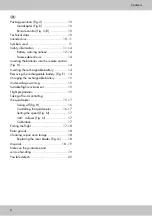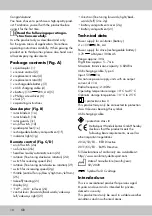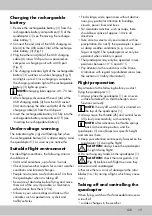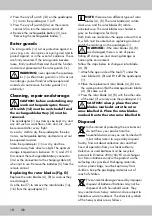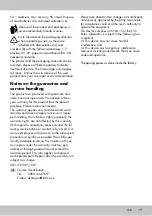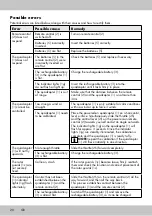
18
2. Press the on/off switch (1d) on the quadcopter
(1) to turn the quadcopter (1) off.
3. Press the on/off (switch) (2a) on the remote
control (2) to turn the remote control off.
4. Remove the rechargeable battery (3) (see
‘Removing the rechargeable battery’).
Rotor guards
The rotor guards (1c) act as protection against in-
juries (e.g. cuts, skin injuries or eye injuries) and to
protect against, or in the event of, collisions. These
are firmly mounted. If the rotor guards become
loose, firmly reattach them and check the function
and correct placement of the rotor guards (1c).
WARNING:
never operate the quadcop-
ter (1) without rotor guards (1c)! So as not
to endanger yourself and/or other people and
animals, do not remove the rotor guards (1c)
arbitrarily!
Cleaning, repair and storage
CAUTION:
before undertaking any
work on the quadcopter, the on/
off switch (1d) must be switched off and
the rechargeable battery (3) must be
removed.
The quadcopter (1) must always be kept dry, and
any dirt such as wool fibres, hair, dust, etc., must
be removed after every flight.
Use a dry cloth to dry the quadcopter; the elec-
tronics, rechargeable battery and motor must not
be exposed to water.
Store the quadcopter (1) in a dry, dust-free
location away from direct sunlight. The optimum
storage temperature is between 10°C and 25°C.
Disconnect the rechargeable battery connector
(3a) or the connection to the charging cable (4)
when not in use. Remove the batteries (5) from the
remote control.
Replacing the rotor blades (Fig. G)
Replace the rotor blades (A), (B) as soon as they
are damaged.
Use the tool (7) to remove the rotor blades (1a),
(1b) from the quadcopter (1).
NOTE:
there are two different types of rotor
blades (A), (B). The rotor blades (A) rotate
clockwise, and the rotor blades (B) rotate
anti-clockwise. The rotor blades are shaded in
grey on the diagrams for clarity.
Both kinds are marked on the upper side with A or
B, which must be noted when replacing and must
match the markings on the quadcopter (1).
WARNING:
if the rotor blades (A), (B)
are damaged, there is a risk of pieces
falling off during use and causing damage or
harming the environment.
Follow the steps below to change a rotor blade
(A), (B):
1. Attach the open side of the tool (7) under the
rotor blade (A), (B) and lift it off the quadcopter
(1).
2. Place the replacement rotor blade (A), (B) into
the same position that the damaged rotor blade
(A), (B) came out of.
3. Press the rotor blade (A), (B) with the other side
of the tool (7) securely onto the quadcopter (1).
CAUTION:
always place the rotor
blades marked A onto the rotor
arms labelled A. Place the rotor blades
marked B onto the rotor arms labelled B.
Disposal
In the interest of protecting the environment,
do not throw your product into the
household waste once you are finished with
it, but rather take it to a specialty disposal
facility. Find out about collection sites and their
hours of operation from your local authority.
Defective or used batteries must be recycled
pursuant to Directive 2006/66/EC and changes
to it. Return batteries and/or the product via the
collecting sites provided. Packaging materials,
such as plastic bags, must be kept away from
children. Keep the packaging materials out of
reach of children.
Environmental damage caused by improper
disposal of batteries! Batteries may not be
disposed of with household waste. They
may contain toxic heavy metals and are subject to
hazardous waste treatment. The chemical symbols
of the heavy metals are as follows:
GB




